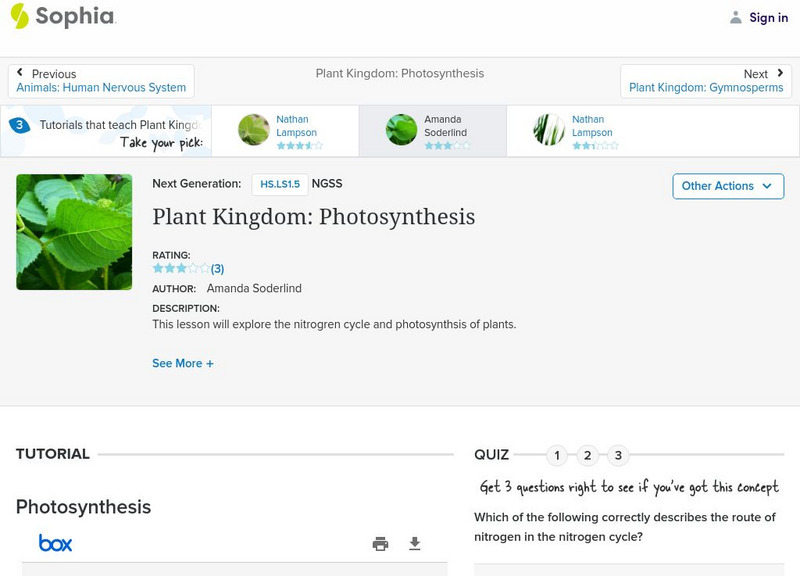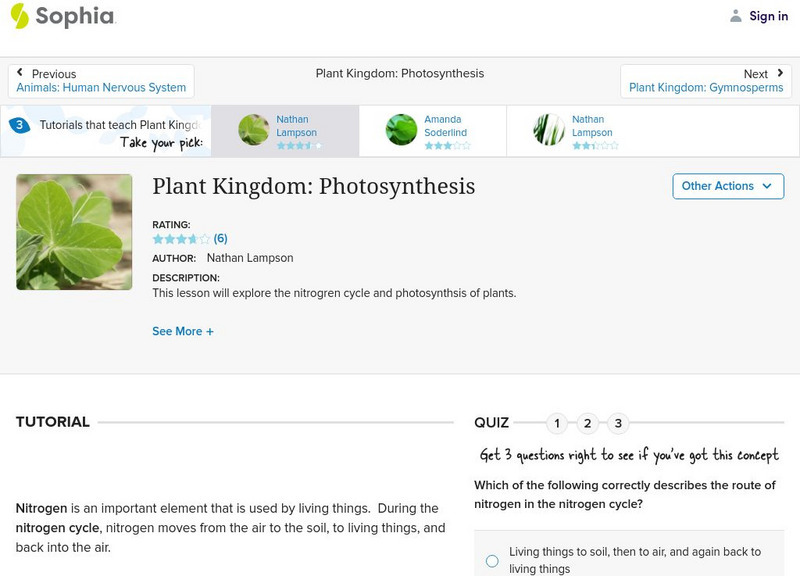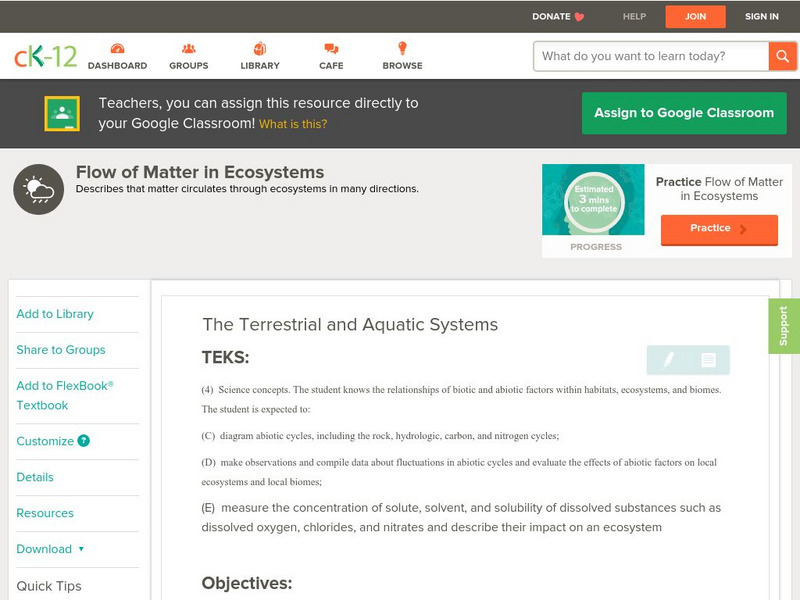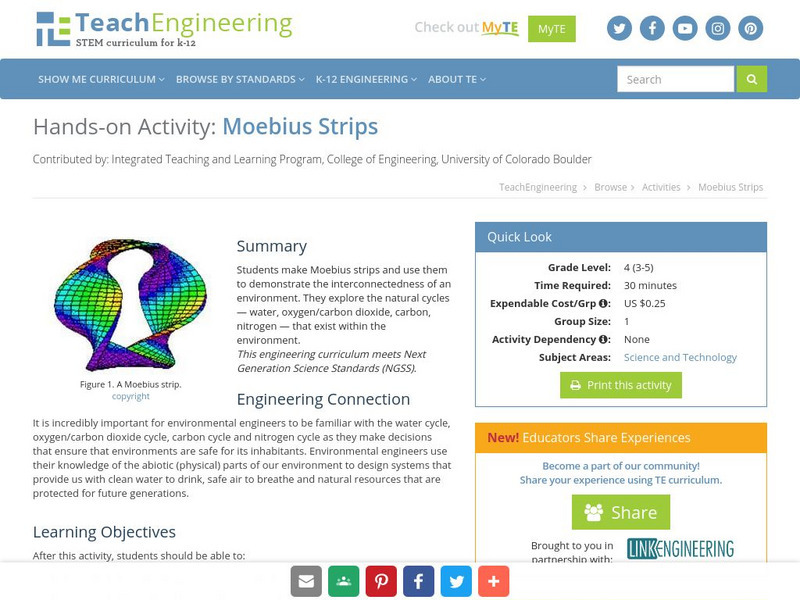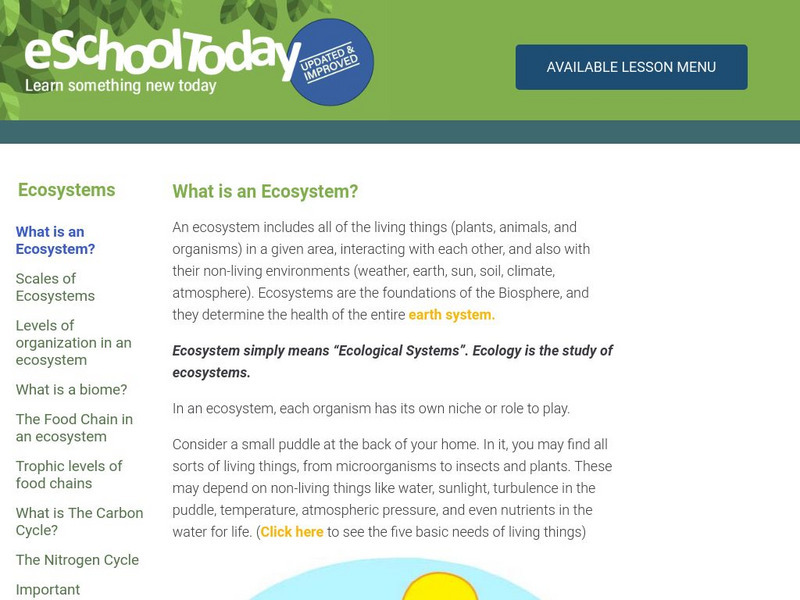National Earth Science Teachers Association
Windows to the Universe: Ammonia Nh3
Read about the chemical compound ammonia and learn how it is part of the Nitrogen Cycle.
TeachEngineering
Teach Engineering: Go With the Energy Flow
Students learn about energy and nutrient flow in various biosphere climates and environments. They learn about herbivores, carnivores, omnivores, food chains and food webs, seeing the interdependence between producers, consumers and...
Sophia Learning
Sophia: Plant Kingdom: Photosynthesis: Lesson 2
This lesson will explore the nitrogren cycle and photosynthsis of plants. It is 2 of 3 in the series titled "Plant Kingdom: Photosynthesis."
Sophia Learning
Sophia: Plant Kingdom: Photosynthesis: Lesson 1
This lesson will explore the nitrogren cycle and photosynthsis of plants. It is 1 of 3 in the series titled "Plant Kingdom: Photosynthesis."
CK-12 Foundation
Ck 12: Earth Science: Flow of Matter in Ecosystems
[Free Registration/Login may be required to access all resource tools.] In this module, students will learn about the cycles of nature (water, carbon, nitrogen, and phosphorus) that support the flow of nutrient matter through an...
TeachEngineering
Teach Engineering: Moebius Strips
In this activity, students make Moebius strips and use them to demonstrate the interconnectedness of an environment. They will explore the natural cycles (water, oxygen/carbon dioxide, carbon, nitrogen) within the environment.
Other
Marietta College: Ecosystems
Complete illustrated discussion of energy flow within ecosystems, including discussions of trophic levels, ecological pyramids, food chains and webs, biological magnification, and cycles.
Ohio State University
Ohio State University: Concepts of Plant Ecology
An advanced discussion of plant interactions and relationships. Energy flow, nutrient cycling and succession are discussed. Try the quiz to check your understanding.
eSchool Today
E School Today: What Is an Ecosystem?
Learn about all the different levels of ecosystems, from the living things under a rock, up to a rainforest biome. Explains the levels of organization within an ecosystem, the different types of biomes, food chains and trophic levels,...
TeachEngineering
Teach Engineering: Biodomes
Students explore the biosphere's environments and ecosystems, learning along the way about the plants, animals, resources and natural cycles of our planet. Over the course of lessons 2-6, students use their growing understanding of...
BioMan Biology
Bio Man Biology: Angry Aliens: Ecology
Teach aliens about ecology as you play this game, and review your own understanding in the process. Topics covered include levels of organization, ecological relationships, nutrition and energy, cycles (water, carbon, and nitrogen), and...
Other
University of Delaware: Chemosynthesis.
An explanation of how in the deep sea, where the sun's rays never reach, organisms make food from chemicals, a process called chemosynthesis.
NOAA
Noaa: Estuaries 101 Curriculum: Nutrients in an Estuary
An overload of nutrients, called eutrophication (Greek for "good-nutrition"), can be harmful to estuaries. This phenomenon is also referred to as "over-enrichment," or "nutrient pollution". Students will investigate the range of...
Georgia Department of Education
Ga Virtual Learning: Ap Environmental Science: Science, Matter, Energy, Systems
Through interactive activities, reading exercises, and lab activities, students study how science, matter, energy, and systems are interrelated.
BioMan Biology
Bio Man Biology: Ecology Quizzes
Three multiple-choice quizzes on topics and vocabulary in ecology.
CPALMS
Florida State University Cpalms: Florida Students: Conservation of Mass and Energy in Living Systems
Learn about the conservation of mass and energy as it applies to different living systems.
Annenberg Foundation
Annenberg Learner: The Control a Haber Bosch Ammonia Plant
An activity where students try to optimize profits by producing the largest daily output of ammonia by simulating the Haber-Bosch process. Students will use their knowledge of equilibrium reactions and the effects of variables like...
TED Talks
Ted: Ted Ed: The Haber Process
Though it has increased food supply worldwide, the Haber process has taken an unforeseen toll on the environment. Daniel D. Dulek delves into the chemistry and consequences of this. [5:19]
TeachEngineering
Teach Engineering: Environment
Through 10 lessons and more than 20 hands-on activities, students are introduced to the concept of an environment and the many interactions within it. As they learn about natural and human-made environments, as well as renewable and...
University of Illinois
University of Illinois Extension: Energy and Ecosystems Use Some Lose Some
Life on Earth is possible because energy flows one way through ecosystems, while matter cycles endlessly. Water and elements, such as carbon, nitrogen, phosphorous, and sulfur are examples of matter that cycles through ecosystems.




